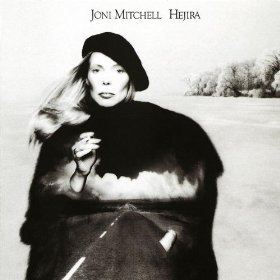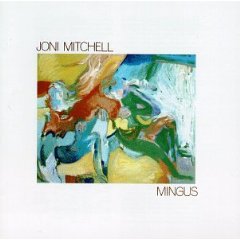 I was (briefly) in college in 1992. My best friend was a very talented drummer name Mike. We played in a jazz group together called, for no apparent reason, the Pre-Flattened Cats.
I was (briefly) in college in 1992. My best friend was a very talented drummer name Mike. We played in a jazz group together called, for no apparent reason, the Pre-Flattened Cats.
One day I was in Mike’s room, high up in one of the dorm towers, sitting on the windowsill and looking out over the sunlit fields that ringed our small state school in northern New York. Mike said, “I’m going to put on a record for you and you’re either going to fall in love with it or never like it.” And he started “Coyote,” the first track on Joni Mitchell’s 1976 masterpiece Hejira. Given that I just referred to it as a masterpiece, you can probably guess which side of his challenge I fell on.
I was already a fan of big band jazz, and I’d started to get more into small-group jazz, largely under Mike’s tutelage. He also introduced me to people like Roky Erickson & the 13th Floor Elevators and The Band. Joni Mitchell was a new name to me, but I could instantly hear in Hejira a blend of the folk, rock and improvised musics that were the hallmark of that phase of her career.
When it came to recruiting personnel, Mitchell didn’t mess around. Hejira features a cast of jazz heavyweights, including guitarist Larry Carlton, clarinetist Abe Most, trumpeter Chuck Findley, saxophonist Tom Scott, vibraphonist Victor Feldman, and bassist Jaco Pastorius. A quick game of “jazz family tree” shows you how connected these players are to the jazz pantheon:
- Pastorius is a legend in his own right who is also famous for his time in Weather Report
- Findley has played with everyone from big band maestros Jimmy Dorsey and Doc Severinson (on The Tonight Show) to Miles Davis, Sarah Vaughn and Buddy Rich
- Feldman wrote “Seven Steps to Heaven” and performed on the Miles Davis album of the same name, just one highlight in career that includes time with Woody Herman, Shelley Manne and Buddy DeFranco. (And also with Frank Zappa and Tom Waits.)
And that’s just the tip of the iceberg. What Mitchell got when she hired these players was a direct connection to an improvisational motherlode, and a cast of characters who were at home in a variety of styles. To my ear, it’s the contribution of Pastorius that is most notable and overt. His fluid playing, often at the intersection of the bass and guitar ranges, places the album in a completely different sonic context from many of the albums that came out around this time. Just listen to his briliiant work on “Refuge of the Roads” to get a feel for how Pastorius could contribute to the foundation of a song at the same time as he generated gorgeous melodic content.
Hejira‘s lyrics also include overt nods to jazz and the blues, most notably in the title track, with its reference to clarinetist and bandleader Benny Goodman, and in “Furry Sings The Blues,” with its evocation of W.C. Handy, a pioneering composer who wrote “St. Louis Blues.”
 Just three years later, Mitchell made an even more overtly jazz-based album with bassist and composer Charles Mingus. Mingus once again draws on jazz musicians for its core band, with Weather Report members Pastorius, Wayne Shorter and Peter Erskine joined by genre-crossing pianist Herbie Hancock, who had last played with Shorter in Miles Davis’s band. Also on the album is percussionist Don Alias, another musician whose career spanned a variety of genres. Alias and Pastorius toured with Mitchell in support of the Mingus album.
Just three years later, Mitchell made an even more overtly jazz-based album with bassist and composer Charles Mingus. Mingus once again draws on jazz musicians for its core band, with Weather Report members Pastorius, Wayne Shorter and Peter Erskine joined by genre-crossing pianist Herbie Hancock, who had last played with Shorter in Miles Davis’s band. Also on the album is percussionist Don Alias, another musician whose career spanned a variety of genres. Alias and Pastorius toured with Mitchell in support of the Mingus album.
For me, the highlight of Mingus is “Goodbye Porkpie Hat,” Mingus’s moving tribute to saxoponist Lester Young. Mitchell’s lyrics are masterful, painting a vivid picture of a bygone jazz scene and speaking fearlessly about the racial issues that plagued the club scene in Young’s time.
 The tour for the Mingus album yielded what is, to my ear, one of the greatest live albums in any genre, 1980’s Shadows and Light. This album finds Mitchell in the stellar company of Pastorius and Alias, along with saxophone giant Michael Brecker, guitarist Pat Metheny and keyboardiat Lyle Mays. The music is uncompromising, featuring all of Mitchell’s lyricism and beauty alongside blistering solo performances by Brecker, Pastorius and Metheny. If you’ve got time for just one track, start off with “Black Crow,” which will have you doing the scrunched-up “jazz stink face” in no time as Brecker and Pastorius peel the paint off the stage with their fiery playing.
The tour for the Mingus album yielded what is, to my ear, one of the greatest live albums in any genre, 1980’s Shadows and Light. This album finds Mitchell in the stellar company of Pastorius and Alias, along with saxophone giant Michael Brecker, guitarist Pat Metheny and keyboardiat Lyle Mays. The music is uncompromising, featuring all of Mitchell’s lyricism and beauty alongside blistering solo performances by Brecker, Pastorius and Metheny. If you’ve got time for just one track, start off with “Black Crow,” which will have you doing the scrunched-up “jazz stink face” in no time as Brecker and Pastorius peel the paint off the stage with their fiery playing.
Mitchell’s music of this period is proof that improvisation — and the language of jazz — can play a vital role in popular music. If you’re looking for a gateway drug, any of these albums is a great entry point to dealing with heavyweight playing, and a little more digging into albums by the musicians in Mitchell’s bands will lead you to a treasure trove of music by acknowledged masters.
[kml_flashembed movie="http://www.youtube.com/v/sg7F2-rYXno" width="600" height="344" allowfullscreen="true" fvars="fs=1" /]

![Reblog this post [with Zemanta]](http://img.zemanta.com/reblog_e.png?x-id=b4e732c9-e866-488d-8b5f-5c46a792ff33)



Comments